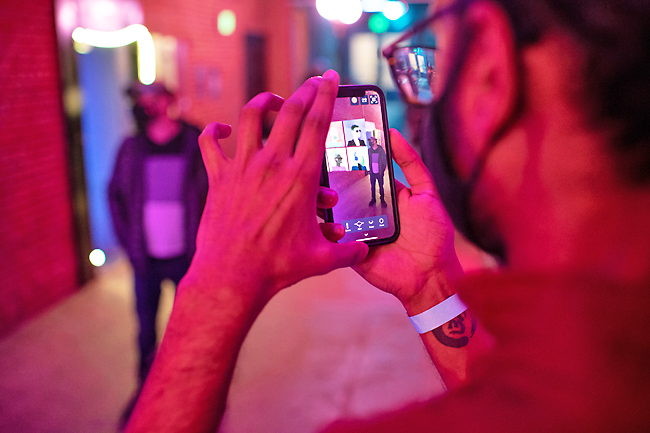Lisa Bonos
THE WASHINGTON POST – “Are we in the metaverse right now?” I ask the man in line behind me. We’ve been waiting about 30 minutes to be outfitted with holographic glasses that will make 3D digital images appear in rooms that, to the naked eye, look empty.
Once we have on our glasses, a whimsical forest with falling origami-shaped leaves appears in one room, the skull of Abraham Lincoln in another. A horse neighs down the hall. As we wait, a child twirls around a virtual ballerina as his parent cautions him to look out for the flesh-and-blood humans.
We’re at Verse, an art exhibit where nothing is nailed to the walls and visitors can walk right through the digital images before them. It’s held at the Mint, a stately building in downtown San Francisco. In the 1870s, the Mint was said to have housed nearly one-third of the nation’s wealth. The vaults that once held gold are now bare, and the brick-walled space is a backdrop for weddings, haunted houses and tonight’s display of non-fungible tokens, or NFTs.
Peter, who’s waiting patiently in line behind me, says that yes, we’re in a version of the metaverse. He declines to use his full name because he works at Meta, the company formerly known as Facebook, which is working hard to convince the world that this next version of the Internet will be awesome.
The term metaverse was coined 30 years ago by novelist Neal Stephenson, who imagined a science fictional universe where avatars inhabit a virtual world similar to our physical one.

Peter’s boss, Meta co-founder and chief executive Mark Zuckerberg, called the metaverse “an embodied Internet where you’re in an experience, not just looking at it.” Like walking through an exhibit of 3D art, going to virtual concerts or conferences.
In the metaverse, paper money is replaced by cryptocurrency, which you need to buy the art dancing before your eyes at the Mint. Each NFT costs between USD25 and USD250,000, though they’re priced in various cryptocurrencies.
The NFT craze has already ensnared Melania Trump (she is selling 10,000 NFTs for USD50 each to celebrate moments during her husband’s presidency), Paris Hilton and the descendants of Pablo Picasso (who created a digital spinoff of the Spanish artist’s work). An NFT of NSA whistleblower Edward Snowden sold for more than USD5 million last year.
But wandering through the Mint, Sari Stenfors is skeptical.
Everyone is talking about the metaverse, Stenfors said, “but not so many people are actually visiting it”. A self-described “futurist” from Berkeley, California, she stands in front of a television screen that projects fiery wings off her back. Stenfors thinks she resembles a heavenly creature or something from hell – she’s not sure which.
“I keep feeling like I’m at Burning Man, but I want to touch and interact more,” Stenfors said.
“Touch is needed. I’m sure it’s going to come. Smells. We’re going to get it all.”
Later she straps on a HoloLens2 – a bulky USD3,500 pair of glasses from Microsoft – and tries not to bump into anyone. Being transported to another world is uncomfortable. For my maiden voyage, the HoloLens is screwed on too tight and leaves a mark on my forehead that’s visible hours later.
Before a Verse attendant sends me to explore on my own, she asks whether I can see the ballerina pirouetting down the hallway. When I reach my hand out in front of me, its shape is rendered in multicoloured polygons, twisting as I turn my hand this way and that. Instead of a traditional art exhibit with plaques on the walls, at Verse, attendees point the cursor in their HoloLens toward a square icon to reveal who made the NFT, its price and a little about the artist’s intention in creating it. This is about commerce, after all.
Sure, it’s cool to be immersed in a forest or walk past glowing lotus flowers, but navigating it is difficult. The glasses call for precise movements, and most Verse attendees are still learning. I aim my HoloLens at a specific icon, and if I move my head just a smidge, the display vanishes. There’s so much to absorb that it’s easy to forget to blink or to feel nauseated.
A banner in LED lights beckons attendees to ponder “What Is Real?” as they wander from one hologram to the next, potentially missing a huge artefact in plain sight: A stamp mill from the late 1800s, used to pulverize quartz so that gold could be extracted. Advanced technology for its time that’s now obsolete. At one point, I reach out and touch an empty brick wall to remind myself that the physical world exists not just as a container or a backdrop. Tiny grains of brick dust fall to the floor.
Wandering through Verse reminds me of the thrill and disorientation that came with the early days of smartphones.
Accessing email while out and about instead of seated at a desktop at home, looking up maps while en route from point A to point B, sharing pictures of your lunch on social media before you’d taken a single bite, or Googling facts about an old building as you were sitting on its steps.
That was the information overload circa 2007.
The newer version on display at the Mint is even more dizzying. It’s like having a million tabs open in your brain and walking right through them splayed out in front of you.
Learning to use a HoloLens is akin to learning to use a mouse and cursor for the first time, explained Ray Kallmeyer, the start-up founder behind Verse. “We find usually, after 30 to 60 minutes, that people are pretty solid with it,” Kallmeyer said.




